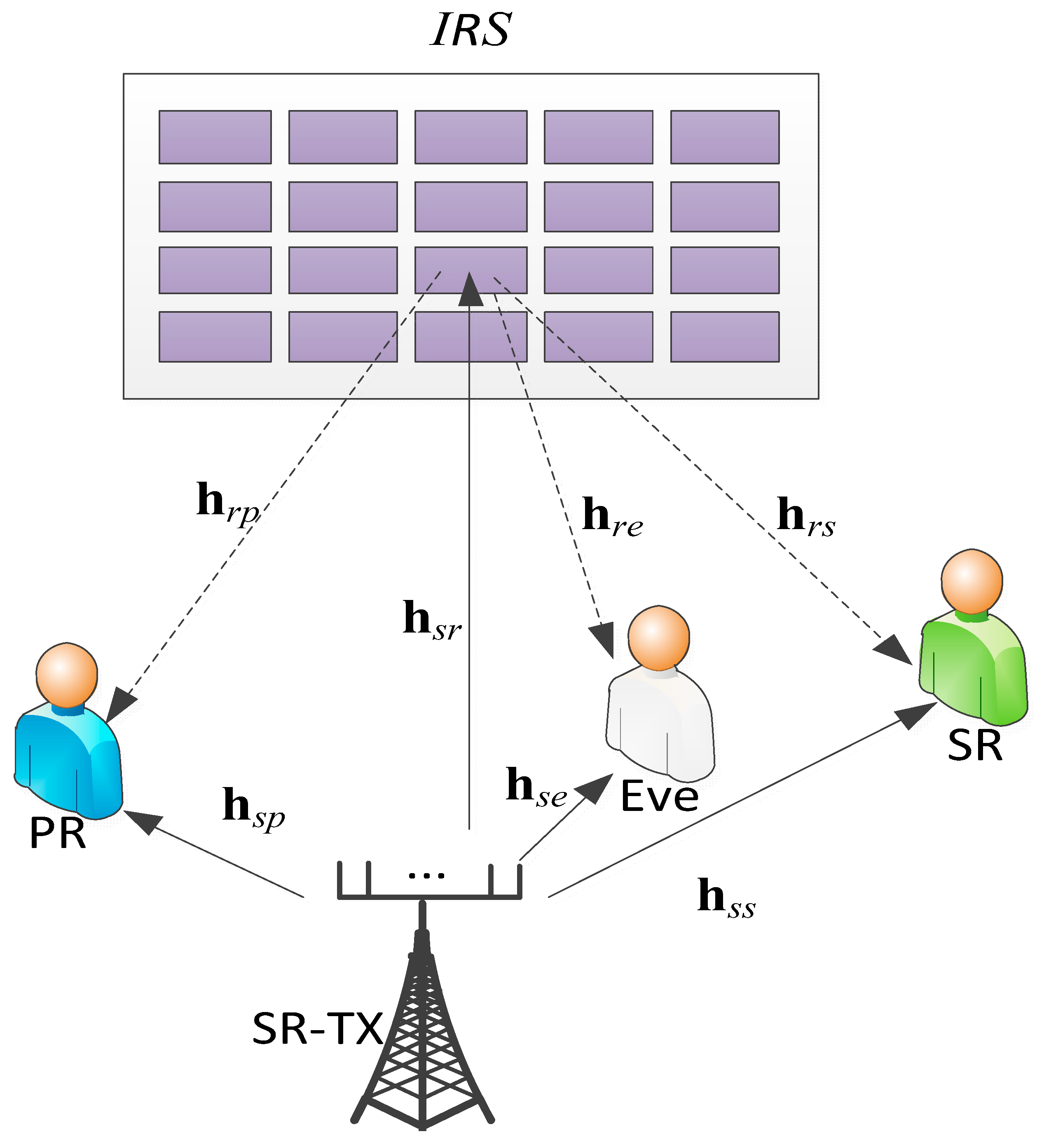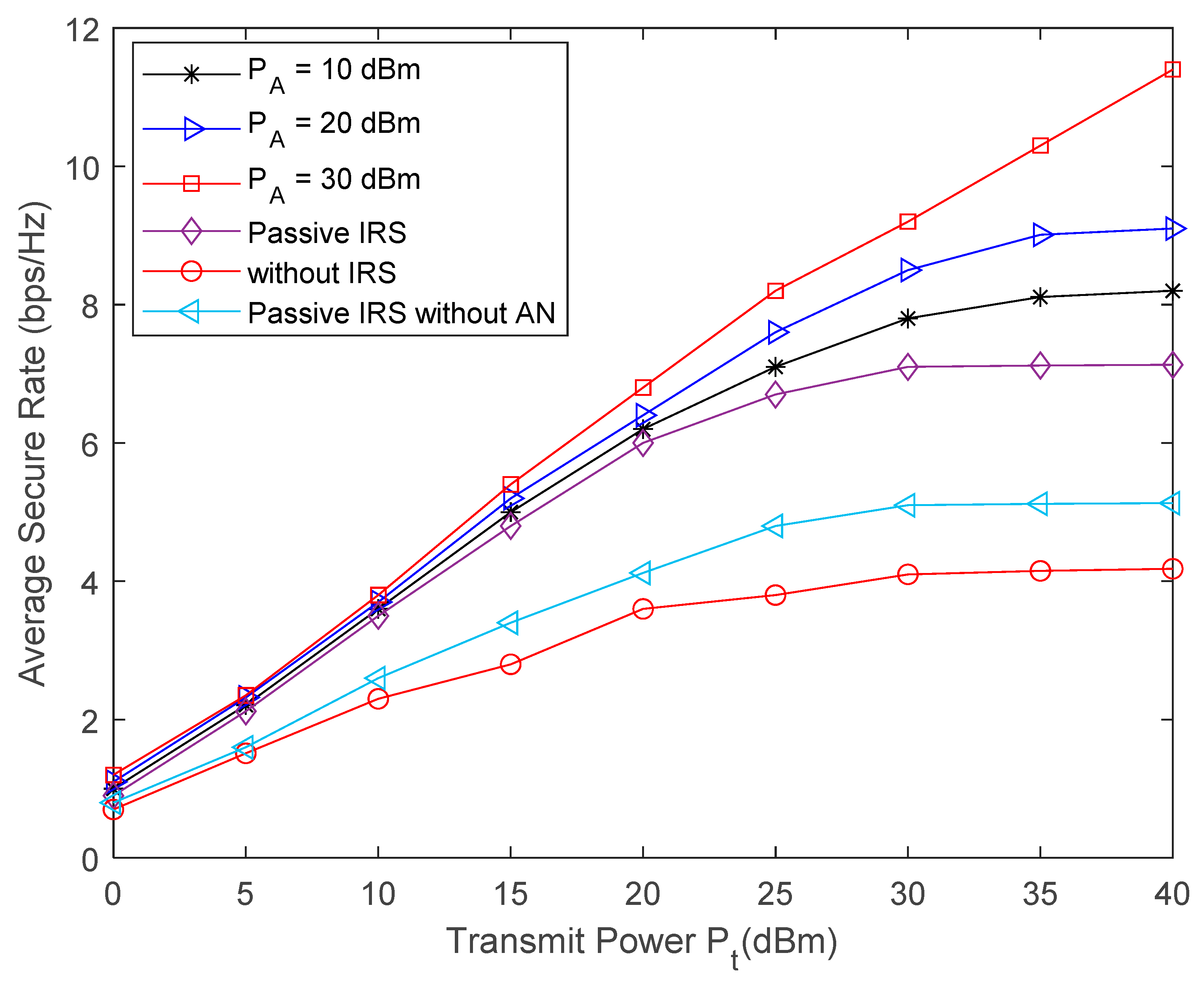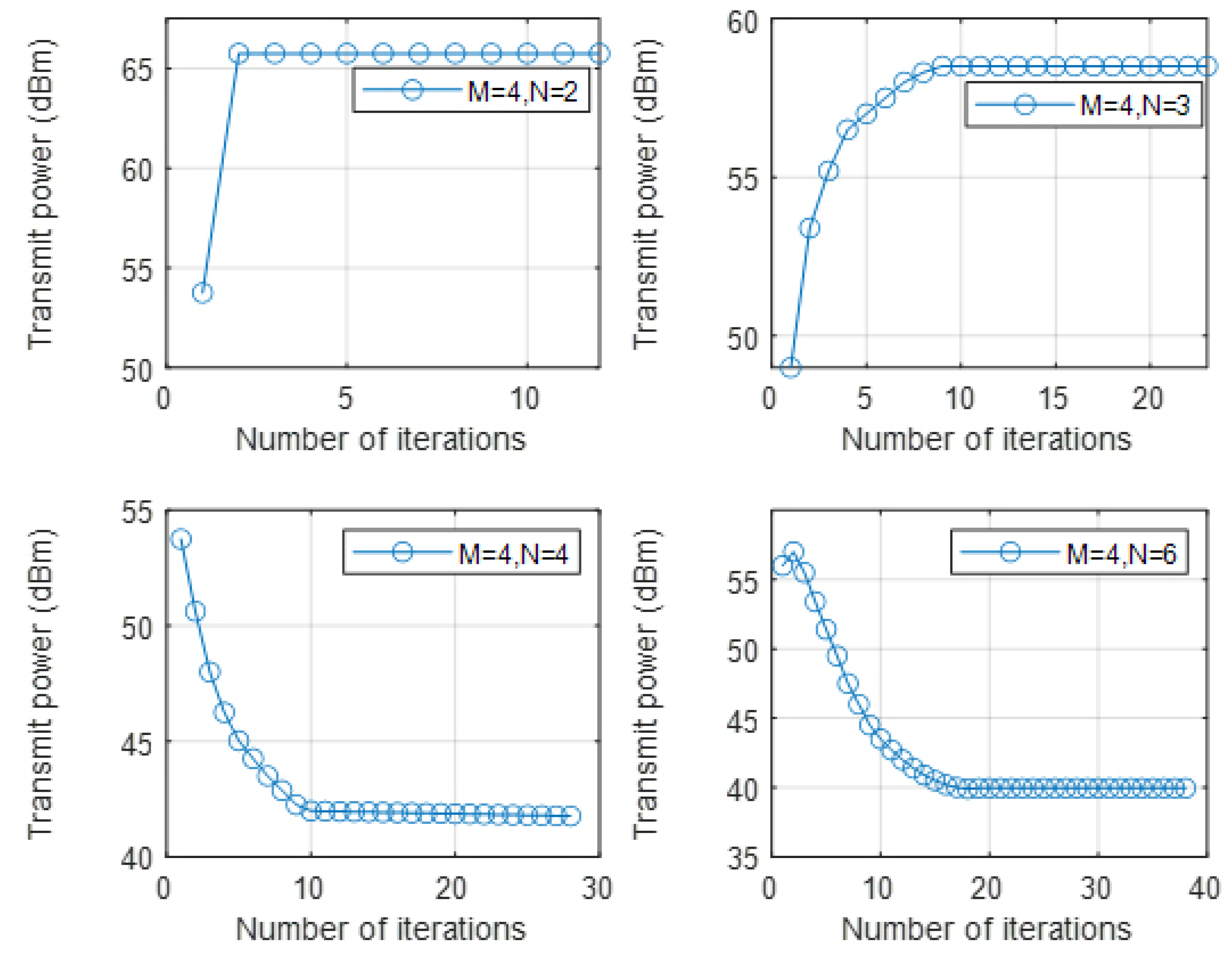Physical Layer Security Performance Analysis of IRS-Aided Cognitive Radio Networks
Abstract
1. Introduction
1.1. Background
1.2. Prior Works
1.3. Motivations and Main Contributions
- First, we optimize the beamforming of base stations for users, the covariance matrix of AN, as well as the phase shift matrix of IRS, which aim to ensure the basic service quality of primary users and maximize the confidentiality of secondary users.
- Second, we propose a BCD-based alternating optimization algorithm to transform the nonconvex problem into a solvable subconvex problem, which can be used to solve nonconvex problems. Furthermore, the SDR was applied to solve the unit module constraint during the solving process.
- Third, we use mathematically equivalent models and related approximate processing schemes to transform the physical layer security performance indicators into easily manageable convex optimization power problems, which has the advantages of greatly reducing computational complexity.
2. System Model
2.1. Main Link
2.2. Eavesdropping Link
3. Problem Formulation
3.1. Interference Power Constraint
3.2. Secrecy Rate Constraints
3.3. Phase Constraint
4. Proposed Solutions
- (1)
- P0-A: s.t. (8), (9), (10), (14), (15), (16)
- (2)
- P0-B: s.t. (8), (9), (10), (11).
4.1. Optimization of and
4.2. Optimization of Phase Matrix
| Algorithm 1 Alternating Optimization Algorithm |
| 1: Input: ,, . 2: Output: , , . 3: Initialize by random generation. 4: repeat 5: Obtain and by solving (P1a) in (24) for given . 6: if or 7: Gaussian randomization algorithm; 8: end 9: Obtain by solving (P2c) in (49) for given and . 10: if 11: Gaussian randomization algorithm; 12: end 13: compute . 14: Update 15: until . |
5. Numerical Results
6. Conclusions
Author Contributions
Funding
Data Availability Statement
Conflicts of Interest
References
- Trindade, S.; da Fonseca, N.L. Channel modeling and characteristics analysis for 6G wireless communications. IEEE Netw. 2021, 35, 296–303. [Google Scholar]
- Hong, S.; Pan, C.; Ren, H.; Wang, K.; Nallanathan, A. Artificial-Noise-Aided Secure MIMO Wireless Communications via Intelligent Reflecting Surface. IEEE Trans. Commun. 2020, 68, 7851–7866. [Google Scholar] [CrossRef]
- Wu, Q.; Zhang, R. Towards Smart and Reconfigurable Environment: Intelligent Reflecting Surface Aided Wireless Network. IEEE Commun. Mag. 2020, 58, 106–112. [Google Scholar] [CrossRef]
- Hong, S.; Pan, C.; Ren, H.; Wang, K.; Chai, K.K.; Nallanathan, A. Robust Transmission Design for Intelligent Reflecting Surface-Aided Secure Communication Systems with Imperfect Cascaded CSI. IEEE Trans. Wirel. Commun. 2020, 20, 2487–2501. [Google Scholar] [CrossRef]
- Nguyen, V.-D.; Duong, T.Q.; Dobre, O.A.; Shin, O.-S. Joint Information and Jamming Beamforming for Secrecy Rate Maximization in Cognitive Radio Networks. IEEE Trans. Inf. Forensics Secur. 2016, 11, 2609–2623. [Google Scholar] [CrossRef]
- Jiang, H.; Xiong, B.; Zhang, H.; Basar, E. Physics-Based 3D End-to-End Modeling for Double-RIS Assisted Non-stationary UAV-to-Ground Communication Channels. IEEE Trans. Commun. 2023. [Google Scholar] [CrossRef]
- Jiang, H.; Xiong, B.; Zhang, H.; Basar, E. Hybrid Far- and Near-field Modeling for Reconfigurable Intelligent Surface Assisted V2V Channels: A Sub-Array Partition Based Approach. IEEE Trans. Wirel. Commun. 2023. [Google Scholar] [CrossRef]
- Yu, X.; Xu, D.; Schober, R. Enabling Secure Wireless Communications via Intelligent Reflecting Surfaces. In Proceedings of the 2019 IEEE Global Communications Conference (GLOBECOM) 2019, Waikoloa, HI, USA, 9–13 December 2019; pp. 1–6. [Google Scholar] [CrossRef]
- Fang, S.; Chen, G.; Li, Y. Joint Optimization for Secure Intelligent Reflecting Surface Assisted UAV Networks. IEEE Wirel. Commun. Lett. 2020, 10, 276–280. [Google Scholar] [CrossRef]
- Lu, X.; Yang, W.; Guan, X.; Wu, Q.; Cai, Y. Robust and Secure Beamforming for Intelligent Reflecting Surface Aided mmWave MISO Systems. IEEE Wirel. Commun. Lett. 2020, 9, 2068–2072. [Google Scholar] [CrossRef]
- Guan, X.; Wu, Q.; Zhang, R. Joint Power Control and Passive Beamforming in IRS-Assisted Spectrum Sharing. IEEE Commun. Lett. 2020, 24, 1553–1557. [Google Scholar] [CrossRef]
- Long, R.; Liang, Y.-C.; Pei, Y.; Larsson, E.G. Active Reconfigurable Intelligent Surface-Aided Wireless Communications. IEEE Trans. Wirel. Commun. 2021, 20, 4962–4975. [Google Scholar] [CrossRef]
- Zhi, K.; Pan, C.; Ren, H.; Chai, K.K.; Elkashlan, M. Active IRS versus passive IRS: Which is superior with the same power budget? arXiv 2021, arXiv:2112.07510. [Google Scholar]
- Khoshafa, M.H.; Ngatched, T.M.N.; Ahmed, M.H.; Ndjiongue, A.R. Active Reconfigurable Intelligent Surfaces-Aided Wireless Communication System. IEEE Commun. Lett. 2021, 25, 3699–3703. [Google Scholar] [CrossRef]
- Zeng, P.; Qiao, D.; Wu, Q.; Wu, Y. Active IRS aided WPCNs: A new paradigm towards higher efficiency and wider coverage. arXiv 2021, arXiv:2111.11600. [Google Scholar]
- Xu, D.; Yu, X.; Ng, D.W.K.; Schober, R. Resource Allocation for Active IRS-Assisted Multiuser Communication Systems. In Proceedings of the 2021 55th Asilomar Conference on Signals, Systems, and Computers 2021, Pacific Grove, CA, USA, 31 October–3 November 2021; pp. 113–119. [Google Scholar] [CrossRef]
- You, C.; Zhang, R. Wireless communication aided by intelligent reflecting surface: Active or passive? IEEE Wirel. Commun. Lett. 2021, 10, 2659–2663. [Google Scholar] [CrossRef]
- Liu, K.; Zhang, Z.; Dai, L.; Xu, S.; Yang, F. Active reconfigurable intelligent surface: Fully-connected or sub-connected? IEEE Commun. Lett. 2021, 26, 167–171. [Google Scholar] [CrossRef]
- Dai, L.; Wang, B.; Wang, M.; Yang, X.; Tan, J.; Bi, S.; Xu, S.; Yang, F.; Chen, Z.; Di Renzo, M.; et al. Reconfigurable intelligent surface-based wireless communications: Antenna design, prototyping, and Experimental Results. IEEE Access 2020, 8, 45913–45923. [Google Scholar] [CrossRef]
- Zhang, L.; Pan, C.; Wang, Y.; Ren, H.; Wang, K.; Nallanathan, A. Robust Beamforming Optimization for Intelligent Reflecting Surface Aided Cognitive Radio Networks. In Proceedings of the GLOBECOM 2020–2020 IEEE Global Communications Conference, Taipei, Taiwan, 7–11 December 2020; pp. 1–6. [Google Scholar] [CrossRef]
- Xiao, H.; Dong, L.; Wang, W. Intelligent Reflecting Surface-Assisted Secure Multi-Input Single-Output Cognitive Radio Transmission. Sensors 2020, 20, 3480. [Google Scholar] [CrossRef]
- Guan, X.; Wu, Q.; Zhang, R. Intelligent reflecting surface assisted secrecy communication: Is artificial noise helpful or not? IEEE Wirel. Commun. Lett. 2020, 9, 778–782. [Google Scholar] [CrossRef]
- Abdullah, Z.; Chen, G.; Lambotharan, S.; Chambers, J.A. A Hybrid Relay and Intelligent Reflecting Surface Network and Its Ergodic Performance Analysis. IEEE Wirel. Commun. Lett. 2020, 9, 1653–1657. [Google Scholar] [CrossRef]
- Wu, Q.; Zhang, R. Weighted Sum Power Maximization for Intelligent Reflecting Surface Aided SWIPT. IEEE Wirel. Commun. Lett. 2020, 9, 586–590. [Google Scholar] [CrossRef]
- Gashtasbi, A.; da Silva, M.M.; Dinis, R.; Guerreiro, J. On the Performance of LDPC-Coded Large Intelligent Antenna System. Appl. Sci. 2023, 13, 4738. [Google Scholar] [CrossRef]
- Gashtasbi, A.; da Silva, M.M.; Dinis, R. IRS, LIS, and Radio Stripes-Aided Wireless Communications: A Tutorial. Appl. Sci. 2022, 12, 12696. [Google Scholar] [CrossRef]
- Alhamad, R.I. Intelligent Reflecting Surfaces with Adaptive Transmit Power and Energy Harvesting for Cognitive Radio Networks. Wirel. Pers. Commun. 2023, 128, 1003–1017. [Google Scholar] [CrossRef]
- Hu, B.; Liu, J.; Wu, W.; Sun, Z. Robust secrecy rate maximization in IRS-assisted cognitive radio networks. Phys. Commun. 2022, 55, 101898. [Google Scholar] [CrossRef]
- Son, P.N.; Duy, T.T.; Tuan, P.V.; Huynh, T.P. Short packet communication in underlay cognitive network assisted by an intelligent reflecting surface. ETRI J. 2023, 45, 28–44. [Google Scholar] [CrossRef]
- Wright, S.J. Coordinate descent algorithms. Math. Program. 2015, 151, 3–34. [Google Scholar] [CrossRef]
- Ma, W.-K.; Davidson, T.; Wong, K.M.; Luo, Z.-Q.; Ching, P.-C. Quasi-maximum-likelihood multiuser detection using semi-definite relaxation with application to synchronous CDMA. IEEE Trans. Signal Process. 2002, 50, 912–922. [Google Scholar] [CrossRef]
- Jiang, H.; Zhang, Z.; Xiong, B.; Dang, J.; Wu, L.; Zhou, J. A 3D Stochastic Channel Model for 6G Wireless Double-IRS Cooperatively Assisted MIMO Communications. In Proceedings of the 2021 13th International Conference on Wireless Communications and Signal Processing (WCSP) 2021, Changsha, China, 20–22 October 2021; pp. 1–5. [Google Scholar] [CrossRef]
- Jiang, H.; He, R.; Ruan, C.; Zhou, J.; Chang, D. Three-Dimensional Geometry-Based Stochastic Channel Modeling for Intelligent Reflecting Surface-Assisted UAV MIMO Communications. IEEE Wirel. Commun. Lett. 2021, 10, 2727–2731. [Google Scholar] [CrossRef]
- Boyd, S.; Vandenberghe, L. Convex Optimization; Cambridge University Press: Cambridge, UK, 2004. [Google Scholar]





Disclaimer/Publisher’s Note: The statements, opinions and data contained in all publications are solely those of the individual author(s) and contributor(s) and not of MDPI and/or the editor(s). MDPI and/or the editor(s) disclaim responsibility for any injury to people or property resulting from any ideas, methods, instructions or products referred to in the content. |
© 2023 by the authors. Licensee MDPI, Basel, Switzerland. This article is an open access article distributed under the terms and conditions of the Creative Commons Attribution (CC BY) license (https://creativecommons.org/licenses/by/4.0/).
Share and Cite
Liu, Z.; Wang, J.; Jiang, H.; Wang, J.; Li, X.; Xie, W. Physical Layer Security Performance Analysis of IRS-Aided Cognitive Radio Networks. Electronics 2023, 12, 2615. https://doi.org/10.3390/electronics12122615
Liu Z, Wang J, Jiang H, Wang J, Li X, Xie W. Physical Layer Security Performance Analysis of IRS-Aided Cognitive Radio Networks. Electronics. 2023; 12(12):2615. https://doi.org/10.3390/electronics12122615
Chicago/Turabian StyleLiu, Zhangyu, Ji Wang, Hao Jiang, Jun Wang, Xingwang Li, and Wenwu Xie. 2023. "Physical Layer Security Performance Analysis of IRS-Aided Cognitive Radio Networks" Electronics 12, no. 12: 2615. https://doi.org/10.3390/electronics12122615
APA StyleLiu, Z., Wang, J., Jiang, H., Wang, J., Li, X., & Xie, W. (2023). Physical Layer Security Performance Analysis of IRS-Aided Cognitive Radio Networks. Electronics, 12(12), 2615. https://doi.org/10.3390/electronics12122615








